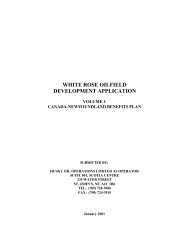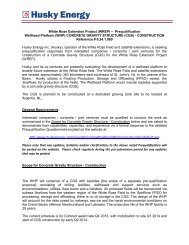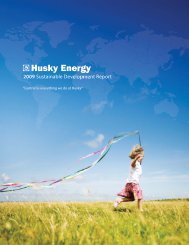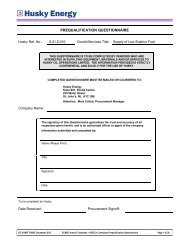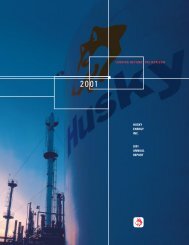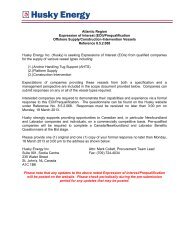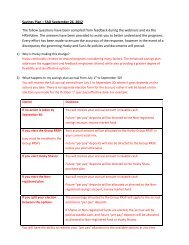white rose oilfield development application - Husky Energy
white rose oilfield development application - Husky Energy
white rose oilfield development application - Husky Energy
- No tags were found...
You also want an ePaper? Increase the reach of your titles
YUMPU automatically turns print PDFs into web optimized ePapers that Google loves.
The principal origins of the icebergs that reach the White Rose location are the 100 tidewater glaciers ofWest Greenland. Between 10,000 and 15,000 icebergs are calved each year, primarily from 20 majorglaciers between the Jacobshaven and Humboldt glaciers. These glaciers account for 85 percent of theicebergs that reach the Grand Banks. According to the International Ice Patrol, the number of icebergsreaching the Grand Banks each year has varied from a low of 0 in 1966 to a high of 2,202 in 1984, withthe average over the last 10 years being approximately 900 icebergs. Of these, only a small proportionpass through the White Rose area. Over the last 10 years, the average yearly number of icebergs sightedin the 1 0 grid containing White Rose has been 47. The maximum number of iceberg sightings was 217in 1990. The number of icebergs peaks in May, but is at relatively high levels from March to June.5.1.1.4 GeologyThe Grand Banks are largely underlain by crystalline and meta-sedimentary rocks of the Avalon terrain,which contain structural fabrics imposed by Caledonian and Hercynian deformation episodes. Side scansonar images of the White Rose area indicate the surficial geology is a thin veneer of fine to mediumgrained sand over a coarser substrate of gravel and gravelly sand. Variable concentrations of benthicorganisms (such as, starfish, brittle stars and bivalves) and cobbles are present. The seabed is relativelystable, with relatively little sedimentary transport within the region. The only seabed features are relatedto seabed disruption by iceberg scouring or dragging of otter trawl doors during fishing activities. TheWhite Rose area is one of relatively low seismic activity.5.1.1.5 Shoreline EnvironmentNewfoundland’s eastern coastline is generally characterized by rocky headlands and steep cliffs withfew, discontinuous pocket beaches and baymouth bars (that is, barachoix). The shoreline varies frombeing deeply indented to straight with few embayments. To a large extent, the <strong>development</strong> of thiscoastline has been strongly influenced by the effects of the last glaciation, as reflected by thepredominantly pebble-gravel beaches in the coastal backshore areas and the rarity of sand-dominatedbeaches along the shoreline. Rivers in the study area are typically small in total volume discharge, witha strong seasonal variation resulting from the annual cycle in precipitation. The tides experienced alongthe coastlines are moderate in size, with normal tidal heights of approximately 1 m. Pack ice is commonalong the shoreline from mid-March to late April.5.1.1.6 Chemical EnvironmentThe concentration of dissolved oxygen in the Grand Banks water column is fairly uniform during thespring with a mean surface value of approximately 8 parts per million (ppm), decreasing toapproximately 7 ppm near the bottom. Suspended particulate matter in the water column ranges from0.01 to 2.77 mg/L and is within ranges reported for other ocean environments. Water samples collectedat the Terra Nova <strong>oilfield</strong> site indicate a mean value of total suspended solids of 2.26 mg/L at the surfaceand 2.17 mg/L near the bottom.White Rose DA Project Summary • January 2001 Page 70



